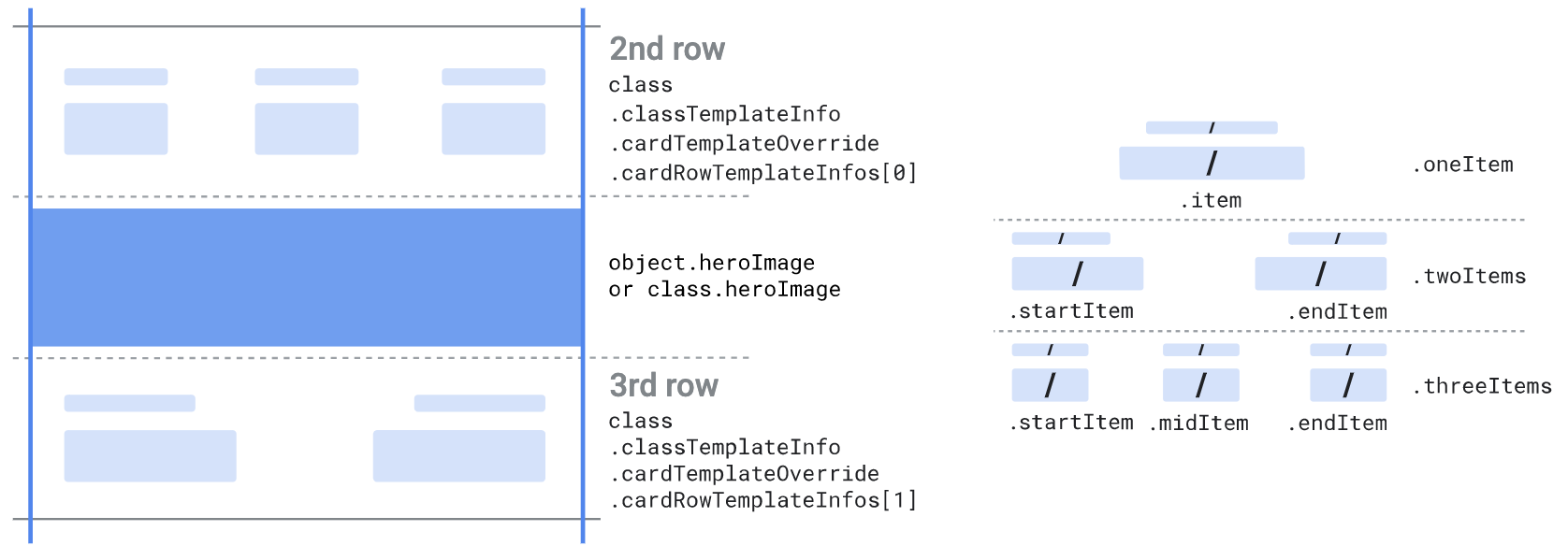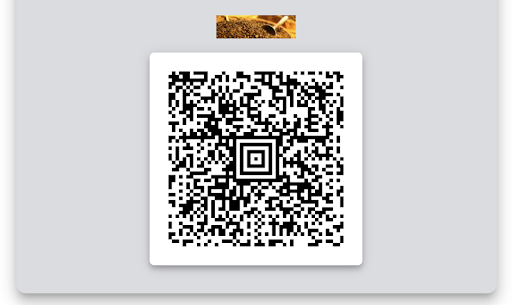บัตรโดยสารรองรับการแสดงภาพเทมเพลต ถ้าไม่ได้กำหนดเทมเพลตไว้ ระบบจะใช้ตัวเลือกเริ่มต้น
คำอธิบายเทมเพลต
เทมเพลตบัตรผ่านได้รับการกำหนดที่ระดับคลาสและจะใช้เพื่อแสดงออบเจ็กต์ที่ ที่เชื่อมโยงกับชั้นเรียน เทมเพลตจะกำหนดว่าช่องใดจะแสดงใน ของบัตรผ่าน
เทมเพลตจะแบ่งออกเป็นส่วนต่างๆ ต่อไปนี้
Android

เว็บ

ชื่อการ์ด
Android

|
ชื่อการ์ดเริ่มต้น
ชื่อการ์ดโลโก้แบบกว้าง
|
เว็บ

|
ชื่อการ์ดเริ่มต้น
ชื่อการ์ดโลโก้แบบกว้าง
|
ส่วนชื่อการ์ดจะแสดงโลโก้ ชื่อผู้ให้บริการขนส่งสาธารณะ และสรุปเส้นทาง องค์ประกอบทั้ง 3 นี้จำเป็นต้องมีและไม่มี การอ้างอิงช่องที่ใช้ป้อนข้อมูลหรืออันดับอาจเปลี่ยนแปลงได้
อย่างไรก็ตาม ตรรกะการแสดงผลจะช่วยให้แถวบนสุดมีความยืดหยุ่นในระดับหนึ่ง สูงสุด
แถวของบัตรผ่าน ซึ่งแสดงสรุปเส้นทางจะควบคุมด้วยสิ่งต่อไปนี้
ในTransitObjectสำหรับการเดินทางเที่ยวเดียว:
object.tripTypeobject.ticketLeg.originNameobject.ticketLeg.destinationNameobject.ticketLeg.originStationCodeobject.ticketLeg.destinationStationCode
วิธีแสดงผลบัตรจะขึ้นอยู่กับช่องที่ไม่ว่างเปล่า ซึ่งสามารถแสดงได้ใน วิธีต่อไปนี้
- ชื่อต้นทางเท่านั้น: ระบบแสดงชื่อต้นทางเท่านั้น โดยเฉพาะอย่างยิ่ง มีประโยชน์สำหรับตั๋วที่ครอบคลุมพื้นที่แทนที่จะเป็นเส้นทางที่เฉพาะเจาะจง
- ต้นทางและปลายทาง: ต้นทางอยู่ทางซ้ายมือ และปลายทางอยู่บนถนน
ด้านขวามือ สัญลักษณ์ที่อยู่ระหว่างทั้งสองจะขึ้นอยู่กับประเภทของการเดินทาง ต้นทางและ
ปลายทางจะแสดงเป็นค่าใดค่าหนึ่งต่อไปนี้
- ชื่อและรหัสสถานี: เราจะแสดงรหัสสถานีที่มีชื่อเป็นข้อความขนาดเล็กบน ด้านบน
- ชื่อเท่านั้น: เราจะแสดงชื่อ
- รหัสสถานีเท่านั้น: เราจะแสดงรหัสสถานี
วัตถุ TransitObject แบบหลายขาทำงานคล้ายกันมาก ในกรณีนี้ อย่าใส่
ใช้ object.ticketLeg คุณต้องใช้ object.ticketLegs[] แทน
รายการ ต้องกำหนดทั้งต้นทางและปลายทาง ชื่อหรือรหัสสถานี หรือทั้ง 2 อย่าง ต้องเป็น
ใช้อย่างสม่ำเสมอในแต่ละขา ต้นทางที่แสดงคือต้นทางขององค์ประกอบแรกใน
ขณะที่ปลายทางที่แสดงคือปลายทางขององค์ประกอบสุดท้ายในอาร์เรย์
สีพื้นหลังของบัตรไม่ใช่ฟิลด์บังคับ และกำหนดได้ทั้งสำหรับฟิลด์ และระดับออบเจ็กต์ ช่องออบเจ็กต์มีลำดับความสำคัญสูงกว่าและใช้งานได้ เพื่อลบล้างฟิลด์คลาส
เมื่อตั้งค่าช่องโลโก้แบบกว้างแล้ว ในอุปกรณ์ Android ส่วนหัวของเทมเพลตเริ่มต้นที่มีค่า โลโก้และชื่อผู้ออกบัตรจะแทนที่ด้วยโลโก้แบบกว้าง
โปรดทำตาม หลักเกณฑ์เกี่ยวกับรูปภาพโลโก้แบบกว้างเมื่อสร้างโลโก้ส่วนหัวแบบกว้างเพื่อประสิทธิภาพที่เหมาะสม แสดงรูปภาพบนบัตร
เทมเพลตการ์ด
Android

เว็บ

ใช้ส่วนเทมเพลตการ์ดเพื่อแสดงแถวเพิ่มเติม แถวเหล่านี้สามารถ มีช่องข้อมูลที่มีโครงสร้างแบบข้อความหรือช่องโมดูลข้อความ
คุณสามารถระบุจำนวนแถวที่กำหนดจำนวนออบเจ็กต์ใน
class.classTemplateInfo.cardTemplateOverride.cardRowTemplateInfos[]
รายการ รายการนี้ต้องมีองค์ประกอบอย่างน้อย 1 รายการ และเราขอแนะนําให้ใช้ไม่เกิน
องค์ประกอบ 2 อย่าง องค์ประกอบแต่ละรายการต้องอยู่ในประเภทใดประเภทหนึ่งต่อไปนี้
-
oneItemซึ่งยอมรับ 1 รายการ:item
-
twoItemsซึ่งยอมรับ 2 รายการ ได้แก่startItemendItem
-
threeItemsซึ่งยอมรับ 3 รายการ ได้แก่startItemmiddleItemendItem
แต่ละรายการสามารถกำหนดให้เป็นตัวเลือกช่องเดียวได้
(.firstValue) ตัวเลือกช่อง 2 รายการ (.firstValue และ
.secondValue) หรือรายการที่กำหนดล่วงหน้า
(.predefinedItem) ทั้งค่าของช่องที่เลือกและค่า
ป้ายกำกับที่เกี่ยวข้องจะปรากฏขึ้น เมื่อคุณกำหนดตัวเลือกช่อง 2 รายการ
ค่าของฟิลด์ที่เลือกจะแสดงด้วยเครื่องหมาย "/" เส้นแบ่ง เรื่อง
สำหรับป้ายกำกับของฟิลด์ที่เลือก รายการที่กำหนดไว้ล่วงหน้าใช้เพื่อ
กำหนดการแสดงผลที่ซับซ้อนยิ่งขึ้น
ตัวอย่างโค้ดต่อไปนี้แสดงวิธีลบล้างแถวการ์ดเทมเพลตการ์ด
เพื่อระบุ 2 แถว แต่ละแถวจะมีรายการ 3 รายการที่แต่ละแถว
อ้างอิงช่องที่กำหนดเอง textModuleData ระดับชั้นเรียน 6 ช่องและ
ส่วนหัวเป็นป้ายกำกับ:
Python
{ ... //Rest of class "textModulesData": [ { "header": "Label 1", "body": "Some info 1", "id": "myfield1" }, { "header": "Label 2", "body": "Some info 2", "id": "myfield2" }, { "header": "Label 3", "body": "Some info 3", "id": "myfield3" }, { "header": "Label 4", "body": "Some info 4", "id": "myfield4" }, { "header": "Label 5", "body": "Some info 5", "id": "myfield5" }, { "header": "Label 6", "body": "Some info 6", "id": "myfield6" } ], "classTemplateInfo": { "cardTemplateOverride": { "cardRowTemplateInfos": [{ "threeItems": { "startItem": { "firstValue": { "fields": [{ "fieldPath": "class.textModulesData['myfield1']" }] } }, "middleItem": { "firstValue": { "fields": [{ "fieldPath": "class.textModulesData['myfield2']" }] } }, "endItem": { "firstValue": { "fields": [{ "fieldPath": "class.textModulesData['myfield3']" }] } }, } },{ "threeItems": { "startItem": { "firstValue": { "fields": [{ "fieldPath": "class.textModulesData['myfield4']" }] } }, "middleItem": { "firstValue": { "fields": [{ "fieldPath": "class.textModulesData['myfield5']" }] } }, "endItem": { "firstValue": { "fields": [{ "fieldPath": "class.textModulesData['myfield6']" }] } }, } }] } } }
Java
// Rest of class .setTextModulesData((new ArrayList<TextModuleData>() { { add((new TextModuleData()).setHeader("Label 1") .setBody("Some info 1") .setId("myfield1")); add((new TextModuleData()).setHeader("Label 2") .setBody("Some info 1") .setId("myfield2")); add((new TextModuleData()).setHeader("Label 3") .setBody("Some info 3") .setId("myfield3")); add((new TextModuleData()).setHeader("Label 4") .setBody("Some info 4") .setId("myfield4")); add((new TextModuleData()).setHeader("Label 5") .setBody("Some info 5") .setId("myfield5")); add((new TextModuleData()).setHeader("Label 6") .setBody("Some info 5") .setId("myfield6")); } })) .setClassTemplateInfo((new ClassTemplateInfo()) .setCardTemplateOverride((new CardTemplateOverride()) .setCardRowTemplateInfos(new ArrayList<CardRowTemplateInfo>() { { add((new CardRowTemplateInfo()).setThreeItems((new CardRowThreeItems()) .setStartItem((new TemplateItem()).setFirstValue((new FieldSelector()).setFields(new ArrayList<FieldReference>(){ { add((new FieldReference()).setFieldPath("class.textModulesData['myfield1']")); } }))) .setMiddleItem((new TemplateItem()).setFirstValue((new FieldSelector()).setFields(new ArrayList<FieldReference>(){ { add((new FieldReference()).setFieldPath("class.textModulesData['myfield2']")); } }))) .setEndItem((new TemplateItem()).setFirstValue((new FieldSelector()).setFields(new ArrayList<FieldReference>(){ { add((new FieldReference()).setFieldPath("class.textModulesData['myfield3']")); } }))) )); add((new CardRowTemplateInfo()).setThreeItems((new CardRowThreeItems()) .setStartItem((new TemplateItem()).setFirstValue((new FieldSelector()).setFields(new ArrayList<FieldReference>(){ { add((new FieldReference()).setFieldPath("class.textModulesData['myfield4']")); } }))) .setMiddleItem((new TemplateItem()).setFirstValue((new FieldSelector()).setFields(new ArrayList<FieldReference>(){ { add((new FieldReference()).setFieldPath("class.textModulesData['myfield5']")); } }))) .setEndItem((new TemplateItem()).setFirstValue((new FieldSelector()).setFields(new ArrayList<FieldReference>(){ { add((new FieldReference()).setFieldPath("class.textModulesData['myfield6']")); } }))) )); } })))
PHP
// Rest of class $textModulesData1 = new Google_Service_Walletobjects_TextModuleData(); $textModulesData1->setBody("Some info 1"); $textModulesData1->setHeader("Label 1"); $textModulesData1->setId("myfield1"); $textModulesData2 = new Google_Service_Walletobjects_TextModuleData(); $textModulesData2->setBody("Some info 2"); $textModulesData2->setHeader("Label 2"); $textModulesData2->setId("myfield2"); $textModulesData3 = new Google_Service_Walletobjects_TextModuleData(); $textModulesData3->setBody("Some info 3"); $textModulesData3->setHeader("Label 3"); $textModulesData3->setId("myfield3"); $textModulesData4 = new Google_Service_Walletobjects_TextModuleData(); $textModulesData4->setBody("Some info 4"); $textModulesData4->setHeader("Label 4"); $textModulesData4->setId("myfield4"); $textModulesData5 = new Google_Service_Walletobjects_TextModuleData(); $textModulesData5->setBody("Some info 5"); $textModulesData5->setHeader("Label 5"); $textModulesData5->setId("myfield5"); $textModulesData6 = new Google_Service_Walletobjects_TextModuleData(); $textModulesData6->setBody("Some info 6"); $textModulesData6->setHeader("Label 6"); $textModulesData6->setId("myfield6"); $textModulesDatas = array($textModulesData1, $textModulesData2, $textModulesData3, $textModulesData4, $textModulesData5, $textModulesData6); $startItemField = new Google_Service_Walletobjects_FieldReference(); $startItemField->setFieldPath("class.textModulesData['myfield1']"); $startItemFirstValue = new Google_Service_Walletobjects_FieldSelector(); $startItemFirstValue->setFields(array($startItemField)); $startItem = new Google_Service_Walletobjects_TemplateItem(); $startItem->setFirstValue($startItemFirstValue); $middleItemField = new Google_Service_Walletobjects_FieldReference(); $middleItemField->setFieldPath("class.textModulesData['myfield2']"); $middleItemFirstValue = new Google_Service_Walletobjects_FieldSelector(); $middleItemFirstValue->setFields(array($middleItemField)); $middleItem = new Google_Service_Walletobjects_TemplateItem(); $middleItem->setFirstValue($middleItemFirstValue); $endItemField = new Google_Service_Walletobjects_FieldReference(); $endItemField->setFieldPath("class.textModulesData['myfield3']"); $endItemFirstValue = new Google_Service_Walletobjects_FieldSelector(); $endItemFirstValue->setFields(array($endItemField)); $endItem = new Google_Service_Walletobjects_TemplateItem(); $endItem->setFirstValue($endItemFirstValue); $cardRowTemplate = new Google_Service_Walletobjects_CardRowThreeItems(); $cardRowTemplate->setStartItem($startItem); $cardRowTemplate->setMiddleItem($middleItem); $cardRowTemplate->setEndItem($endItem); $cardRowTemplateInfo1 = new Google_Service_Walletobjects_CardRowTemplateInfo(); $cardRowTemplateInfo1->setThreeItems($cardRowTemplate); $startItemField2 = new Google_Service_Walletobjects_FieldReference(); $startItemField2->setFieldPath("class.textModulesData['myfield4']"); $startItemFirstValue2 = new Google_Service_Walletobjects_FieldSelector(); $startItemFirstValue2->setFields(array($startItemField2)); $startItem2 = new Google_Service_Walletobjects_TemplateItem(); $startItem2->setFirstValue($startItemFirstValue2); $middleItemField2 = new Google_Service_Walletobjects_FieldReference(); $middleItemField2->setFieldPath("class.textModulesData['myfield5']"); $middleItemFirstValue2 = new Google_Service_Walletobjects_FieldSelector(); $middleItemFirstValue2->setFields(array($middleItemField2)); $middleItem2 = new Google_Service_Walletobjects_TemplateItem(); $middleItem2->setFirstValue($middleItemFirstValue2); $endItemField2 = new Google_Service_Walletobjects_FieldReference(); $endItemField2->setFieldPath("class.textModulesData['myfield6']"); $endItemFirstValue2 = new Google_Service_Walletobjects_FieldSelector(); $endItemFirstValue2->setFields(array($endItemField2)); $endItem2 = new Google_Service_Walletobjects_TemplateItem(); $endItem2->setFirstValue($endItemFirstValue2); $cardRowTemplate2 = new Google_Service_Walletobjects_CardRowThreeItems(); $cardRowTemplate2->setStartItem($startItem2); $cardRowTemplate2->setMiddleItem($middleItem2); $cardRowTemplate2->setEndItem($endItem2); $cardRowTemplateInfo2 = new Google_Service_Walletobjects_CardRowTemplateInfo(); $cardRowTemplateInfo2->setThreeItems($cardRowTemplate2); $cardTemplateOverride = new Google_Service_Walletobjects_CardTemplateOverride(); $cardTemplateOverride->setCardRowTemplateInfos(array($cardRowTemplateInfo1, $cardRowTemplateInfo2)); $classTemplateInfo = new Google_Service_Walletobjects_ClassTemplateInfo(); $classTemplateInfo->setCardTemplateOverride($cardTemplateOverride); $payload->setTextModulesData($textModulesDatas); $payload->setClassTemplateInfo($classTemplateInfo);
โค้ดจะสร้างบัตรผ่านด้วยรูปแบบส่วนเทมเพลตโค้ดดังต่อไปนี้:

หากรายการว่างเปล่า ระบบจะไม่แสดงรายการนั้น ดูรายละเอียดเพิ่มเติมได้ที่ การอ้างอิงช่อง หากรายการทั้งหมดในแถวเป็น ว่างเปล่า แถวจะไม่แสดงขึ้น หากบางรายการในแถวว่างเปล่า รายการที่ไม่ว่างเปล่าจะได้รับการจัดเรียงใหม่ และแสดงเป็นแถวที่มีรายการน้อยลง
ถ้าคุณไม่ลบล้างเทมเพลตการ์ด จำนวนแถวที่เป็นค่าเริ่มต้น จำนวนรายการเริ่มต้น และการอ้างอิงฟิลด์เริ่มต้น สำหรับข้อมูลเพิ่มเติม โปรดดูรายละเอียดที่หัวข้อเทมเพลตเริ่มต้น
หลังจากกำหนด
รูปภาพหลัก รูปภาพนี้จะปรากฏหลังจากแถวแรก หากมีหลายแถวใน
cardRowTemplateInfos หรือเหนือแถว หากมี
ข้อแรก
บาร์โค้ดของบัตร
Android

|
|
เว็บ

|
|
ส่วนบาร์โค้ดของบัตรใช้เพื่อแสดงข้อความหรือรูปภาพเพิ่มเติมด้านบนและด้านล่าง บาร์โค้ด คุณไม่จำเป็นต้องกรอกข้อมูลในช่องในส่วนนี้
มีตัวเลือก 3 ช่องที่สามารถใช้เพื่อกำหนดช่อง 2 ช่องแบบเคียงข้างกันได้ ด้านบนและด้านล่างของบาร์โค้ด ระบบจะแสดงข้อความเหล่านี้ โดยไม่มีป้ายกำกับ และสามารถเป็น ช่องข้อมูลที่มีโครงสร้างแบบข้อความ ช่องโมดูลข้อความ หรือช่องโมดูลรูปภาพ หากคุณ ใช้รูปภาพ เนื่องจากควรเป็นไปตามหลักเกณฑ์การใช้แบรนด์
บาร์โค้ดจะถูกกำหนดตามประเภทและค่า สำหรับรายการประเภทบาร์โค้ดที่รองรับ ดูข้อมูลอ้างอิง นอกจากนี้ ข้อความอาจเป็น ที่แสดงอยู่ใต้บาร์โค้ด ข้อความนี้จะช่วยให้สแกนบาร์โค้ดได้ง่ายขึ้น การใช้งานอื่นๆ
ตัวอย่างโค้ดต่อไปนี้แสดงวิธีลบล้างส่วนบาร์โค้ดของบัตรที่จะแสดง รูปภาพเหนือบาร์โค้ด
Python
#... rest of class "imageModulesData": [ { "mainImage": { "sourceUri": { "uri": "http://farm4.staticflickr.com/3738/12440799783_3dc3c20606_b.jpg", "description": "Coffee" } }, "id": "myimage" } ], "classTemplateInfo": { "cardBarcodeSectionDetails": { "firstTopDetail": { "fieldSelector": { "fields": [ { "fieldPath": "class.imageModulesData['myimage'].mainImage" } ] } } } } }
Java
//... rest of class .setImageModulesData((new ArrayList<ImageModuleData>() { { add((new ImageModuleData()) .setId("myimage") .setMainImage((new Image()).setSourceUri((new ImageUri()).setDescription("Coffee beans") .setUri("http://farm4.staticflickr.com/3738/12440799783_3dc3c20606_b.jpg")))); } })) .setClassTemplateInfo((new ClassTemplateInfo()) .setCardBarcodeSectionDetails((new CardBarcodeSectionDetails()) .setFirstTopDetail((new BarcodeSectionDetail()) .setFieldSelector((new FieldSelector()) .setFields((new ArrayList<FieldReference>(){ { add((new FieldReference()).setFieldPath("class.imageModulesData['myimage'].mainImage")); } }))))) }
PHP
//... rest of class $imageUri = new Google_Service_Walletobjects_ImageUri(); $imageUri->setUri("https://farm8.staticflickr.com/7340/11177041185_a61a7f2139_o.jpg"); $imageUri->setDescription("Baconrista flights image"); $image = new Google_Service_Walletobjects_Image(); $image->setSourceUri($imageUri); $imageModulesData = new Google_Service_Walletobjects_ImageModuleData(); $imageModulesData->setMainImage($image); $imageModulesData->setId("myimage"); $cardBarcodeFieldReference = new Google_Service_Walletobjects_FieldReference(); $cardBarcodeFieldReference->setFieldPath("class.imageModulesData['myimage'].mainImage"); $cardBarcodeFieldSelector = new Google_Service_Walletobjects_FieldSelector(); $cardBarcodeFieldSelector->setFields(array($cardBarcodeFieldReference)); $cardBarcodeDetail = new Google_Service_Walletobjects_BarcodeSectionDetail(); $cardBarcodeDetail->setFieldSelector($cardBarcodeFieldSelector); $cardBarcodeSectionDetails = new Google_Service_Walletobjects_CardBarcodeSectionDetails(); $cardBarcodeSectionDetails->setFirstTopDetail($cardBarcodeDetail); $classTemplateInfo = new Google_Service_Walletobjects_ClassTemplateInfo(); $classTemplateInfo->setCardBarcodeSectionDetails($cardBarcodeSectionDetails); $payload->setClassTemplateInfo($classTemplateInfo); $payload->setImageModuleData($imageModulesData);
โค้ดจะสร้างบัตรที่มีรูปแบบส่วนบาร์โค้ดดังต่อไปนี้

หากคุณไม่ได้ลบล้างส่วนบาร์โค้ด ระบบจะใช้ช่องบาร์โค้ดเริ่มต้น ดูข้อมูลเพิ่มเติมได้ที่เทมเพลตเริ่มต้น
เทมเพลตรายละเอียด
Android

|
|
เว็บ

|
|
ส่วนเทมเพลตรายละเอียดเป็นรายการรายการ
class.classTemplateInfo.detailsTemplateOverride.detailsItemInfos[] รายการเหล่านี้สามารถ
มีช่องข้อมูลที่มีโครงสร้างทุกประเภท ช่องโมดูลข้อความ ช่องโมดูลลิงก์ โมดูลรูปภาพ
หรือข้อความได้
แต่ละรายการจะกำหนดเป็นเครื่องมือเลือกช่องเดียว (.firstValue) ได้
ตัวเลือกช่อง 2 รายการ (.firstValue และ .secondValue) หรือ
รายการที่กำหนดไว้ล่วงหน้า (.predefinedItem) ทั้งค่าของช่องที่เลือกและค่า
ป้ายกำกับที่เกี่ยวข้องจะปรากฏขึ้น เมื่อคุณกำหนดตัวเลือกช่อง 2 รายการ ค่าของฟิลด์
ฟิลด์ที่เลือกจะแสดงด้วยเครื่องหมาย "/" เส้นแบ่ง ป้ายกำกับของ
ฟิลด์ที่เลือก รายการที่กำหนดไว้ล่วงหน้าจะใช้เพื่อกำหนดการแสดงผลที่ซับซ้อนยิ่งขึ้น ช่องโมดูลรูปภาพ
จะแสดงผลด้วยความกว้างเต็มขนาดโดยไม่มีป้ายกำกับ
ตัวอย่างโค้ดต่อไปนี้แสดงวิธีลบล้างส่วนรายละเอียดของบัตรผ่านเพื่อแสดง
ช่อง linksModuleData ที่มีป้ายกำกับ:
Python
//... rest of class "linksModuleData": { "uris": [ { "uri": "http://maps.google.com/", "description": "Nearby Locations", "id":"mylink" } ] }, "classTemplateInfo": { "detailsTemplateOverride": { "detailsItemInfos": [ { "item":{ "firstValue": { "fields": [{ "fieldPath": "class.linksModuleData.uris['mylink']" }] } } } ] } } //... rest of class
Java
//... rest of class .setLinksModuleData((new ArrayList<LinksModuleData>() { { add((new LinksModuleData()).setDescription("Nearby Locations") .setUri("http://maps.google.com/") .setId("mylink")); })) .setClassTemplateInfo((new ClassTemplateInfo()) .setDetailsTemplateOverride((new DetailsTemplateOverride()) .setDetailsItemInfos(new ArrayList<DetailsItemInfo>(){ { add((new DetailsItemInfo()) .setItem((new TemplateItem()).setFirstValue((new FieldSelector()).setFields(new ArrayList<FieldReference>(){ { add((new FieldReference()).setFieldPath("class.linksModuleData.uris['mylink']")); } })))); } })) //... rest of class
PHP
//... rest of class building $locationUri = new Google_Service_Walletobjects_Uri(); $locationUri->setUri("http://maps.google.com/"); $locationUri->setDescription("Nearby Locations"); $locationUri->setId("mylink"); $linksModuleData = new Google_Service_Walletobjects_LinksModuleData(); $linksModuleData->setUris(array($locationUri)); $detailItemFieldReference = new Google_Service_Walletobjects_FieldReference(); $detailItemFieldReference->setFieldPath("class.linksModuleData.uris['mylink']"); $detailItemFieldSelector = new Google_Service_Walletobjects_FieldSelector(); $detailItemFieldSelector->setFields(array($detailItemFieldReference)); $detailItem = new Google_Service_Walletobjects_TemplateItem(); $detailItem->setFirstValue($detailItemFieldSelector); $detailsItemInfo = new Google_Service_Walletobjects_DetailsItemInfo(); $detailsItemInfo->setItem($detailItem); $cardDetailsTemplateOverride = new Google_Service_Walletobjects_DetailsTemplateOverride(); $cardDetailsTemplateOverride->setDetailsItemInfos(array($detailsItemInfo)); $classTemplateInfo = new Google_Service_Walletobjects_ClassTemplateInfo(); $classTemplateInfo->setDetailsTemplateOverride($cardDetailsTemplateOverride); $payload->setClassTemplateInfo($classTemplateInfo); $payload->setLinksModuleData($linksModuleData); //... rest of class
โค้ดจะสร้างบัตรด้วยรูปแบบส่วนรายละเอียดต่อไปนี้

หากรายการว่างเปล่า ระบบจะไม่แสดงรายการนั้น ดูรายละเอียดเพิ่มเติมได้ที่ การอ้างอิงช่อง
หากคุณไม่ลบล้างเทมเพลตรายละเอียด รายการช่องอ้างอิงเริ่มต้นใน ลำดับเริ่มต้นจะปรากฏ สำหรับข้อมูลเพิ่มเติม ดูเทมเพลตเริ่มต้น
หากการเดินทางประกอบด้วยหลายขา ระบบจะแสดงแผนการเดินทางง่ายๆ ที่ด้านบนของส่วนนั้นๆ
และย้ายไม่ได้ หากการเดินทางมีแค่ขาเดียว แผนการเดินทางง่ายๆ จะแสดงตาม
การตั้งค่า class.enableSingleLegItinerary

|
|
แสดงรายการเทมเพลต

|
|
ส่วนเทมเพลตรายการใช้เพื่อเลือกช่องที่จะแสดงใน "บัตร" มุมมองของ แอป Google Wallet โดยบัตรจะแสดงในรายการพร้อมด้วยโลโก้ สีพื้นหลัง และ 3 แถว
ตัวอย่างโค้ดต่อไปนี้แสดงวิธีลบล้างเทมเพลตรายการของบัตรเพื่อแสดง ช่องวันที่หมดอายุของออบเจ็กต์ของบัตรเดียวในแถวแรกของเทมเพลตรายการ
Python
#... rest of class definition "classTemplateInfo": { "listTemplateOverride":{ "firstRowOption": { "fieldOption":{ "fields": [{ "fieldPath": "object.validTimeInterval.end" }] } } } } }
Java
//... rest of class .setClassTemplateInfo((new ClassTemplateInfo()) .setListTemplateOverride((new ListTemplateOverride()) .setFirstRowOption((new FirstRowOption()) .setFieldOption((new FieldSelector()).setFields(new ArrayList<FieldReference>(){ { add((new FieldReference()).setFieldPath("object.validTimeInterval.end")); } })))) //... rest of class
PHP
//... rest of class $fieldReference = new Google_Service_Walletobjects_FieldReference(); $fieldReference->setFieldPath("object.validTimeInterval.end"); $fieldOption = new Google_Service_Walletobjects_FieldSelector(); $fieldOption->setFields(array($fieldReference)); $firstRowOption = new Google_Service_Walletobjects_FirstRowOption(); $firstRowOption->setFieldOption($fieldOption); $listTemplateOverride = new Google_Service_Walletobjects_ListTemplateOverride(); $listTemplateOverride->setFirstRowOption($firstRowOption); $classTemplateInfo = new Google_Service_Walletobjects_ClassTemplateInfo(); $classTemplateInfo->setListTemplateOverride($listTemplateOverride); $payload->setClassTemplateInfo($classTemplateInfo); //... rest of class
โค้ดจะสร้างบัตรผ่านด้วยการแก้ไขเทมเพลตรายการดังต่อไปนี้

คุณกำหนดแถวแรกได้ด้วยตัวเลือกช่องหรือแสดงสรุปเส้นทาง รูปแบบของ ข้อมูลสรุปอาจเป็นอย่างใดอย่างหนึ่งต่อไปนี้
originAndDestinationCodesoriginAndDestinationNamesoriginName
คุณกำหนดแถวที่ 2 และ 3 ได้ด้วยตัวเลือกช่องเท่านั้น ช่องจะแสดงโดยไม่มีป้ายกำกับ สำหรับบัตรที่จัดกลุ่มไว้ แถวที่ 2 จะแสดงวันที่ออกเดินทางเสมอ และแถวที่ 3 จะแสดงจำนวนบัตรที่จัดกลุ่มไว้เสมอ
ป้ายกำกับ
ช่อง Structured Data ทั้งหมดมีป้ายกำกับจาก Google Google จะเป็นผู้รับผิดชอบ ให้คำแปลสำหรับป้ายกำกับแต่ละป้ายในทุกภาษาที่รองรับ
คุณสามารถปรับแต่งป้ายกำกับเหล่านี้บางส่วนได้โดยใช้
ฟิลด์ class.custom<name_of_the_field>Label เมื่อปรับแต่งป้ายกำกับ
คุณจะเป็นผู้รับผิดชอบต่อคำแปลสำหรับป้ายกำกับนั้นๆ ในทุกภาษา
ที่ต้องการสนับสนุน
การอ้างอิงช่อง
การอ้างอิงช่องใช้ในส่วนต่างๆ ของเทมเพลตที่มีฟังก์ชัน
แบบฟอร์ม class.classTemplateInfo.*.fields[] การอ้างอิงช่องมีรายการ
ของเส้นทางไปยังช่องข้อมูลที่มีโครงสร้าง ช่องโมดูลข้อความ ช่องโมดูลลิงก์ โมดูลรูปภาพ
หรือข้อความได้
เส้นทางบางประเภทไม่ได้รับอนุญาตในการอ้างอิงช่องทุกช่อง เช่น บางช่อง การอ้างอิงจะอนุญาตให้ส่งเฉพาะเส้นทางไปยังช่องข้อมูลที่มีโครงสร้างแบบข้อความหรือช่องโมดูลข้อความเท่านั้น ช่องที่มีโครงสร้างที่ใช้ข้อความ คือช่องข้อมูลที่มีโครงสร้างของประเภทสตริง สตริงที่แปลแล้ว วันที่ หรือเงิน
โดยรายการนี้สามารถใช้เพื่อติดตั้งใช้งานตรรกะสำรอง ซึ่งหมายความว่าหากเส้นทางแรกใน รายการจะเปลี่ยนเป็นช่องว่าง ระบบจะประเมินเส้นทางถัดไป ตรรกะสำรองคือ กำหนดเป้าหมายไปที่ช่องข้อมูลที่มีโครงสร้างแบบข้อความหรือช่องโมดูลข้อความเป็นหลัก ไม่ผสม ประเภทต่างๆ ในรายการเดียวกัน โปรดใช้ตรรกะสำรองด้วยความระมัดระวังและ ในบางสถานการณ์ เมื่อคุณคาดหวังรูปแบบฟิลด์ที่สอดคล้องกัน ซึ่งมีอยู่ในบางฟิลด์ แต่ไม่ใช่วัตถุอื่นๆ ส่วนใหญ่แล้ว การสร้างชั้นเรียนแยกต่างหากจะเป็นเรื่องง่ายกว่า Use Case แยกต่างหาก
หากเส้นทางทั้งหมดในรายการอ้างอิงช่องเปลี่ยนเป็นช่องว่าง รายการที่ใช้ ช่องอ้างอิงจะไม่ปรากฏ ถ้าต้องการรายการที่ใช้การอ้างอิงช่องกับ ปรากฏอยู่เสมอ ตรวจสอบให้แน่ใจว่ามีเส้นทางอย่างน้อย 1 เส้นทางไม่ว่างเปล่า เราขอแนะนำให้คุณ ตั้งค่าช่องเป็นอักขระพิเศษ เช่น "-" เพื่อแทนค่า Null อนุญาตสตริงที่มีช่องว่างเท่านั้น
ในการอ้างอิงฟิลด์ที่มีในรายการ คุณสามารถใช้ดัชนีของฟิลด์ใน
รายการ หรือในกรณีส่วนใหญ่ คุณสามารถใช้รหัสอ้างอิง รายการที่อ้างอิงได้
โดยรหัสจะมีช่อง .id เราขอแนะนำให้คุณใช้รหัสอ้างอิงเหนือดัชนี
ของช่องดังกล่าวในรายการ หากมี
ต่อไปนี้คือตัวอย่างของวิธีอ้างอิงช่องที่มีอยู่ในรายการ
object.imageModulesData[0].id = my-first-idobject.imageModulesData[1].id = my-second-idclass.detailsTemplateOverride.detailsItemInfos[0].item.firstValue.fields[0].fieldPath = object.imageModulesData[‘my-second-id’]class.detailsTemplateOverride.detailsItemInfos[1].item.firstValue.fields[0].fieldPath = object.imageModulesData[0]
ในกรณีนี้ รายการแรกในส่วนรายละเอียดของบัตรจะเป็นรูปภาพที่ 2 ที่ประกาศ ในออบเจ็กต์ แต่รายการที่ 2 ในส่วนรายละเอียดของบัตรจะเป็นรูปภาพแรก ที่ประกาศไว้ในออบเจ็กต์
เทมเพลตเริ่มต้น
Android

|
|
เว็บ

|
|
สำหรับช่องโมดูลรูปภาพ เราจะแสดงช่องโมดูลรูปภาพเพียงช่องเดียวจากชั้นเรียน 1 ช่องและ 1 ช่องและ ฟิลด์โมดูลรูปภาพเพียงฟิลด์เดียวจากออบเจ็กต์ ถ้าคุณต้องการช่องโมดูลรูปภาพที่ ระดับใดระดับหนึ่ง ลบล้างเทมเพลตเริ่มต้น
สำหรับช่องโมดูลข้อความ เราจะแสดงช่องโมดูลข้อความได้สูงสุด 20 ช่องจากชั้นเรียนและ 20 ช่องเท่านั้น ฟิลด์โมดูลข้อความจากออบเจ็กต์ ช่องจะแสดงตามลำดับ ที่กำหนดไว้ในอาร์เรย์ หากคุณต้องการฟิลด์โมดูลข้อความมากกว่า 20 ฟิลด์ในระดับใดระดับหนึ่ง ให้แทนที่ เทมเพลตเริ่มต้น
สำหรับข้อความ เราจะแสดงข้อความจากชั้นเรียนไม่เกิน 20 ข้อความจากชั้นเรียนและ 20 ข้อความจาก ออบเจ็กต์นั้น แต่เราไม่รับประกันลำดับของข้อความ ถ้าคุณต้องการข้อความมากกว่า 20 ข้อความ ระดับใดระดับหนึ่ง หรือการรับประกันคำสั่งซื้อใดๆ จะลบล้างเทมเพลตเริ่มต้น
ไม่มีขีดจำกัดสำหรับจำนวน URI ที่คุณกำหนดในช่องโมดูลลิงก์ URI คือ แสดงผลที่จัดกลุ่มตามลำดับต่อไปนี้สำหรับแต่ละระดับ (คลาสหรือออบเจ็กต์)
- พิกัดแผนที่
- หมายเลขโทรศัพท์
- อีเมล
- หน้าเว็บ
สำหรับแต่ละกลุ่ม URI จะแสดงในลำดับเดียวกับที่กำหนดไว้ในอาร์เรย์ หากต้องการลำดับที่แตกต่างออกไป ให้ลบล้างเทมเพลตเริ่มต้น

|
|

